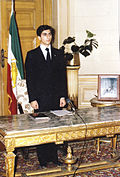Reza Pahlavi, Crown Prince of Iran
Reza Pahlavi (Persian: رضا پهلوی; born 31 October 1960) is the oldest son of Iranian Mohammad Reza Pahlavi and his wife Farah Diba. Until the Iranian Revolution in 1979, he was the crown prince and the last heir apparent to the throne of the Imperial State of Iran.[2]
| Reza Pahlavi | |||||
|---|---|---|---|---|---|
| Crown Prince of Iran | |||||
 Reza in 2015 | |||||
| Head of the House of Pahlavi | |||||
| 31 October 1980[1] – present | |||||
| Predecessor | Farah Diba (as regent in pretence)[1] | ||||
| Born | 31 October 1960
(aged 65) Tehran, Imperial State of Iran | ||||
| Spouse | |||||
| Issue | Princess Noor Princess Iman Princess Farah | ||||
| |||||
| Father | Mohammad Reza Pahlavi | ||||
| Mother | Farah Diba | ||||
| Religion | Shia Islam | ||||
| Party | National Council of Iran | ||||
| Alma mater | Williams College (dropped out) The American University in Cairo (dropped out) University of Southern California (by correspondence) | ||||
| Residence | Bethesda, Maryland, U.S. | ||||
| Website | rezapahlavi | ||||
| Signature | |||||
Reza Pahlavi, Crown Prince Of Iran Media
Ceremony at Pasargadae to mark the 2,500-year celebration of the Persian Empire in 1971; the Crown Prince is at far right, age 10, standing next to his parents.
References
- ↑ 1.0 1.1 "Former Iranian Crown Prince Reza Pahlavi will proclaim himself the new shah of Iran", United Press International, 17 October 1980, retrieved 25 January 2019,
His Imperial Highness Reza Pahlavi, Crown Prince of Iran, will reach his constitutional majority on the 9th of Aban, 1359 (October 31, 1980). On this date, and in conformity with the Iranian Constitution, the regency of Her Imperial Majesty Farah Pahlavi, Shahbanou of Iran, will come to an end and His Imperial Highness, who on this occasion will send a message to the people of Iran, will succeed his father, His Imperial Majesty Mohammed Reza Shah Pahlavi, deceased in Cairo on Mordad 5, 1359 (July 27, 1980).
- ↑ Maciej Milczanowski (2014), "US Policy towards Iran under President Barack Obama's Administration" (PDF), Hemispheres: Studies on Cultures and Societies, Institute of Mediterranean and Oriental Cultures Polish Academy of Sciences, 29 (4): 53–66, ISSN 0239-8818



